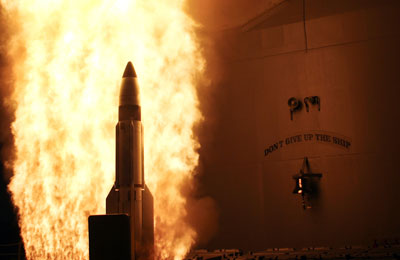Letter: hydrazine reduxby Yousaf Butt
|
| The unique question raised in the purported necessity of intercepting USA 193 was that the hydrazine itself (and not the tank) was the lethal threat. |
Although Professor Higgins’ argument about a kettle filled with water being able to absorb the heat input from a blowtorch is well taken, it is somewhat of an oversimplification when applied to the real world scenario under consideration. Indeed, temperatures deduced from examining re-entered fuel tanks indicate heating to approximately 2500°C, according to one report.
As the fuel line stubs (the remnants of the sheared-off fuel lines) will not be subject to phase-change cooling of the interior multi-phase hydrazine, they will reach roughly this temperature. So, to use a variant of Professor Higgins’ kitchen example, if you take a blowtorch to the region of the kettle containing just the vapor, that region can easily be heated to in excess of 1000°C.
As the hydrazine decomposition reactions are highly exothermic, the vapor ignition will likely perpetuate (through boiling of the liquid and melting of the solid) to consume the remaining hydrazine in the tank—whether the supersonic detonation mentioned by Prof. Higgins occurs or not is not terribly relevant; a standard subsonic chemical deflagaration will suffice. This is backed up by the definitive text on the subject, AIAA’s Special Project Report SP-084-1999 “Fire, Explosion, Compatibility, and Safety Hazards of Hypergols - Hydrazine”, which states:
The detonation of neat liquid hydrazine has not been observed… Although there have been reported explosions of liquid hydrazine, at present none of these observations is thought to be the result of liquid detonation but rather they are attributed to the presence of multiple phases in the liquid hydrazine or other mechanisms.
Furthermore, a completely independent way of initiating the highly exothermic hydrazine decomposition reactions is the fact that, with a probability of 1, the tank and its multi-phase hydrazine contents will be subjected to repeated plasma discharges during reentry.
Lastly, the tank would have been expected to undergo roughly 25g’s of peak deceleration during re-entry—it may be somewhat more or less depending on the unknown initial angle of incidence. As some fraction of the hydrazine will have melted by the time of this peak deceleration, the smaller footprint of the remaining frozen hydrazine on the tank will likely dynamically stress the thin-wall tank beyond its design loads. Think: mixing a martini in an aluminum foil bag!
| The sooner the government chooses to share at least some details of their technical risk analysis, the sooner it would allay the public’s fears that there may have been some other reasons for the $50-million interception. |
In light of the several methods above for either igniting (via heat), initiating (via plasma discharge), or dispersing (via break-up of the tank) the hydrazine, it continues to be difficult to identify any real technical merit to the hydrazine threat story proffered by the authorities. If indeed there is such technical merit, the authorities ought not to be so hesitant to publicize at least the unclassified portions of these studies. It is entirely possible that an empty tank could have made it down intact, but this is hardly a reason for the administration to have decided to intercept the ailing satellite. Such tanks commonly re-enter with no forewarning, let alone interceptions.
Professor Higgins is surely aware that the first step in doing one’s homework is to attempt to answer the questions being posed (the hydrazine threat), not those of one’s choosing (the tank threat). Ultimately, it is only the government agencies who are intimately aware of details of the hydrazine tank design and the probabilities of the reentry survival of its rocket fuel contents. The sooner they choose to share at least some details of their technical risk analysis, the sooner it would allay the public’s fears that there may have been some other reasons for the $50-million interception.
